Experience Kite Surfing Adventures in Charleston SC
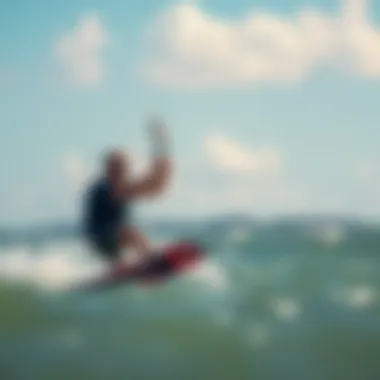
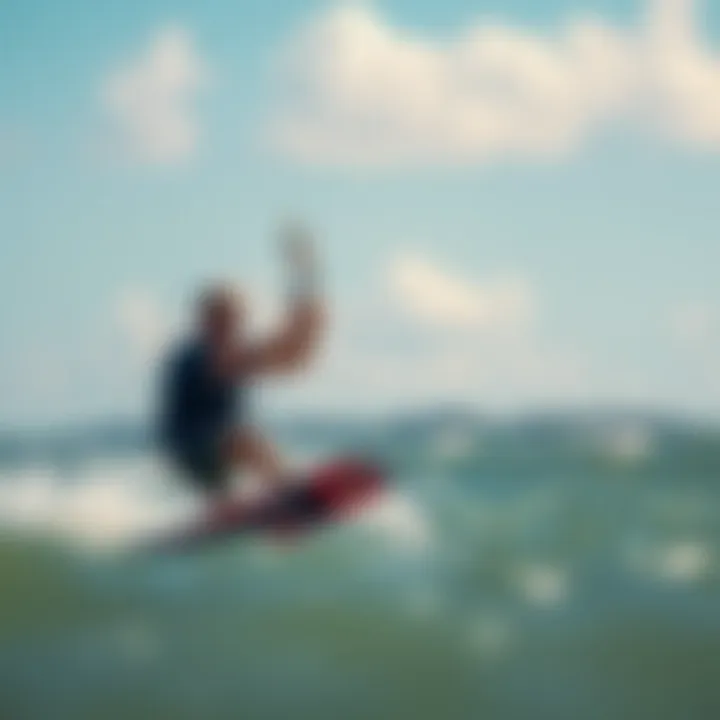
Intro
Kite surfing in Charleston, South Carolina, is not just another sport; it’s a blend of adrenaline, skill, and the enchanting coastal beauty that this charming city offers. With the Atlantic waves crashing gently against the shore and gusty winds swirling through the air, the environment is practically begging to be explored with a kite in tow. As we journey through this guide, we aim to illuminate the vibrant kite surfing scene, encompassing everything from suitable spots for beginners to those who are ready to tackle high-performance gear. Whether you are planning to take your first glide across the waters or you’ve been carving the waves for years, there’s something for everyone in Charleston.
Gear and Equipment
Essential Kiteboarding Gear for Beginners
Starting with kite surfing means equipping yourself with the right tools. An absolute must-have for any newcomer is a quality kite. Brands like Cabrinha and Duotone offer a range tailored to new riders. Look for kites that are easy to handle, with a moderate size to facilitate smoother take-offs and landings.
Another crucial piece of equipment is the control bar. This apparatus not only helps in steering your kite but also serves as a safety mechanism. A reliable harness is equally vital. Opt for a waist harness since it gives you better mobility compared to a seat harness while still providing ample support.
Don’t forget about your board. Beginners should consider a larger board that provides more stability. The Liquid Force Glory or the North Regular are good choices for those just starting out.
Finally, protective gear like a helmet and a wetsuit are important. The helmet can protect you from unexpected falls, while a wetsuit keeps you warm during those chilly morning sessions.
Advanced Equipment for Experienced Riders
Once you're comfortable and ready to step it up a notch, advanced equipment becomes essential. A higher-quality kite, such as the Slingshot Rally or the Naish Pivot, can make a huge difference in performance. These kites offer superior control and responsiveness, enabling tricks that impress onlookers.
For experienced riders, a shorter board, like the Slingshot Asylum, allows for quicker maneuvering and better trick execution. The right control bar, preferably one with adjustable settings, will further enhance your riding experience.
It’s also advisable to explore different styles of kite surfing, like freestyle or wave riding, as each will require specific gear tailored to those disciplines.
"Investing in the right gear is critical to both your safety and your enjoyment of kite surfing. The more comfortable you are with your equipment, the more you'll focus on technique and having fun."
Techniques and Tips
Safety Practices for Kiteboarding
Before you hit the waves, understanding safety protocols is paramount. Always check the weather conditions prior to heading out. Strong winds can quickly become dangerous, especially for novices.
When launching your kite, be aware of your surroundings. Ensure that the area is clear of obstacles like trees or other beachgoers. It sounds obvious, but many accidents stem from simple oversights. Moreover, having a buddy system—where another person can look out for you—is invaluable, particularly if you’re new.
Training Techniques to Improve Your Skills
Practice makes perfect, but quality practice is what leads to improvement. Take lessons from certified instructors who can provide valuable insights into body positioning and technique. Also, focus on kiting drills that build muscle memory. Start with basic skills like controlled turns and progress to jumps and tricks.
Lastly, study videos from professional kite surfers. Observing their technique can highlight mistakes in your own riding. Visual learning complements hands-on practice effectively.
In sum, kite surfing in Charleston offers not just an opportunity to experience the thrill of the wind and waves but also a community of riders united by passion. With suitable gear and an understanding of safety protocols, you can hit the water with confidence, ready to carve your own path through the surf.
Prologue to Kite Surfing in Charleston
Kite surfing holds a unique charm, particularly in a place like Charleston, South Carolina. This coastal city, known for its rich history and stunning landscapes, has emerged as a prime destination for kite surfers from all walks of life. Understanding this sport’s significance in Charleston isn’t just about the thrill; it encompasses local culture, natural conditions, and a growing community of enthusiasts. By exploring the various facets of kite surfing here, readers can appreciate the blend of adventure and serenity that it offers.
Historical Context of Kite Surfing
Kite surfing, in its modern form, began to take shape in the late 20th century, but its roots trace back to ancient uses of kites in various cultures, particularly in Asia. Charleston, with its maritime inclination, played a unique role in this evolution. Early adopters began to appreciate the benefits of harnessing wind power for sport over the years.
The local participation grew gradually, with enthusiasts often reminiscing about the first gatherings at Folly Beach and Sullivan's Island where kite surfers shared tips and stories amid the waves. Today, looking back, it’s clear that Charleston hasn't just embraced kite surfing; it has woven it into its coastal culture, showcasing how a sport can foster connections among community members who share a passion for wind and water.
The Appeal of Charleston's Beaches
Charleston's beaches are a kite surfer’s paradise, and there are a few reasons for this. The enchanting coastlines, like Folly Beach and Kiawah Island, offer consistent wind conditions, making it an excellent venue for both beginners and seasoned veterans of the sport. Moreover, the scenic views while gliding across the water can easily catch anyone's breath.
Another appealing aspect is the versatile conditions available. Whether one prefers the calm surface of a bay or the thrilling challenge of choppy waters, Charleston provides spots to cater to different preferences.
Here’s a quick look at what makes the beaches in Charleston stand out:
- Diverse Conditions: From flat water to ocean waves, ideal for all kite surfing levels.
- Community Vibe: A welcoming atmosphere where surfers exchange knowledge and camaraderie.
- Accessibility: Many beaches are easily reachable with ample parking and amenities, making it a convenient adventure for anyone looking to try kite surfing.
"The beauty of kite surfing in Charleston lies not just in the sport itself, but in the community and the breathtaking backdrop that enhances every ride."
Charleston’s beaches are more than just a playground for kite surfers; they represent the spirit of adventure and joy that comes with riding the wind. In the coming sections, we'll delve deeper into the ideal locations, gear, and techniques to help you embark on your kite surfing journey in this picturesque city.
Ideal Kite Surfing Locations
Kite surfing is not just about the thrill of riding the waves; it's also about choosing the right location. Charleston, SC, offers a delightful array of spots for kite surfers, each with its own charm and challenges. Picking the right place can make all the difference, whether you are just starting out or are a seasoned rider looking for that next rush. The ideal kite surfing spots are characterized by consistent wind patterns, suitable water conditions, and a welcoming community, making them popular choices for local and visiting adventurers alike.
In this section, we'll delve into three of the top kite surfing locations in Charleston: Folly Beach, Kiawah Island, and Sullivan's Island. Each spot has unique features that cater to varying skill levels, ensuring that every kite surfer finds their sweet spot to soar through the skies.
Folly Beach
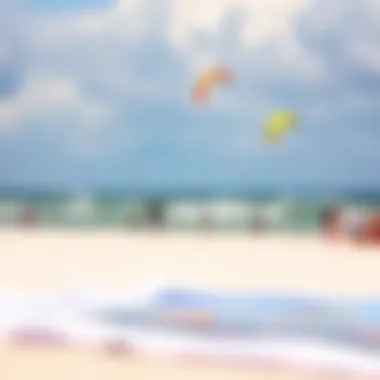
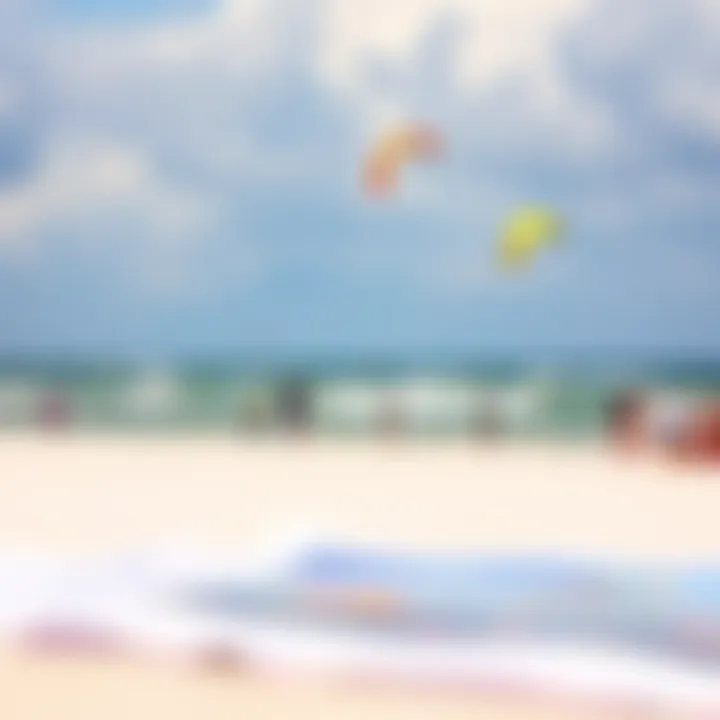
Folly Beach stands out as one of Charleston's premier spots for kite surfing. This location can't be beat for those who are in pursuit of a scenic backdrop and conducive conditions.
Safety and Regulations
Folly Beach has laid out specific safety and regulations to ensure that everyone enjoys their kite surfing experience while minimizing risks. Surfers must adhere to local ordinances, and there are designated areas for kite surfing to maintain a safe environment. Regular checks and balances are in place, with lifeguards monitoring the beach during peak seasons. This emphasis on safety helps newcomers feel more confident as they navigate the waters. Additionally, kite surfing schools operate in the area, offering lessons on regulations and safe practices, which enhances the overall experience for everyone involved. Having such structured rules promotes a culture of respect among surfers and contributes positively to the community spirit.
Best Times to Visit
Timing can be everything when it comes to kite surfing at Folly Beach. Generally, the wind is most favorable during the spring and fall months, with consistent breezes that are friendly to both beginners and experienced riders. The summer can bring stronger winds, but it also draws larger crowds, which might be overwhelming for those just starting out. Early mornings are often calm and enjoyable, providing a tranquil experience as the sun rises. By knowing the best times to hit the water, surfers can maximize their ride and truly embrace the exhilarating experience.
Kiawah Island
Another gem in Charleston's kite surfing lineup is Kiawah Island, known for its gorgeous beaches and unique conditions.
Wind Conditions
Kiawah Island offers impressive wind conditions that add to its allure for kite surfers. The area is typically blessed with steady, strong winds, making it a preferred spot for advanced surfers seeking to catch high-speed rides. The winds here can become quite unpredictable, however, especially in the summer, where thunderstorms can whip up quickly. Familiarizing oneself with the local weather patterns can vastly improve the kite surfing experience, allowing surfers to harness the wind effectively and avoid complications.
Accessibility
When you think about accessibility, Kiawah Island excels in offering ease of access. The island is well-connected and provides ample parking near the beach, which is a key factor for those traveling with gear in tow. However, it's worth noting that much of the island is private, and this can limit access to certain areas. Seeking out public access points ahead of time can save possible headaches and ensure you land in a suitable place to surf.
Sullivan's Island
Lastly, Sullivan's Island presents an exciting community atmosphere for kite surfers, making it a must-visit destination.
Community Atmosphere
The community atmosphere at Sullivan's Island is warm and inviting, which is particularly advantageous for beginners looking for guidance. Surfers often gather at the beach, sharing tips, tricks, and stories. This culture of collaboration fosters a sense of belonging and encourages newcomers to take to the water with more confidence. The social aspect of kite surfing here reflects a strong communal bond that adds to the enjoyment of the sport. Furthermore, local stores and rentals cater specifically to kite surfers, ensuring that anyone can gear up and join in.
Local Events
Sullivan's Island hosts various local events throughout the season, which can be a fantastic way to connect with other kite surfers. These gatherings promote camaraderie and often feature competitions or casual meet-ups. For enthusiasts, participating in these events not only hones their skills but also enhances community ties and promotes kite surfing as an enjoyable, shared passion. The lively nature of these happenings makes Sullivan's Island a vibrant hub for both seasoned surfers and those eager to learn.
By exploring these locations in Charleston, kite surfers can find not just suitable spots but also cultivate a richer connection to the sport and the community surrounding it.
Understanding Wind Patterns
Kite surfing relies heavily on the wind, so grasping the wind patterns in Charleston is essential. Understanding these patterns not only helps in predicting the best times to ride but also ensures safety on the water. Wind influences everything from the type of equipment a kiteboarder should use to the techniques required for safely launching and landing the kite.
Seasonal Variability
Wind conditions can vary significantly with seasons in Charleston. During the summer months, expect more consistent winds coming from the southeast. This is generally when kite surfing is at its peak, as warm weather invites many enthusiasts to the water. The wind can average between 15 to 25 knots, creating optimal conditions for both beginners and seasoned kiteboarders.
Conversely, the winter months can be quite different. Winds may come from the north or northeast, bringing colder air. Although less predictable, these winds tend to be stronger, which might appeal to more experienced kite surfers looking for that additional thrill. Weather fronts can change swiftly, so it's wise to keep an eye on local forecasts.
In spring and autumn, the winds can be quite variable. Spring often brings refreshing breezes that add excitement to the surf scene, whereas autumn might present gusty winds that can shift unexpectedly. Staying in tune with the seasonal winds can lead to more enjoyable and safe kite surfing experiences.
Predicting Wind Conditions
To ensure a successful kite surfing outing, one must be adept at predicting wind conditions. Being able to read wind patterns can mean the difference between a disastrous day and a thrilling, memorable ride.
Kiteboarders often rely on various tools and resources to get current conditions. Weather apps like Windy and local resources such as https://www.weather.gov offer real-time data on wind speed and direction. These can be invaluable in making a last-minute decision about whether to hit the beach.
Additionally, understanding certain local indicators can also help in predicting conditions. For example, noticing the movement of boats can provide clues about the wind direction. If they’re moving steadily, there’s likely a decent breeze. On the flip side, calm conditions on the water may indicate lesser winds, which might not be ideal for kite surfing.
"The thrill of kite surfing often lies in the dance with the wind; it’s not just a sport; it�’s an experience powered by nature itself."
Essential Gear for Kite Surfing
Kite surfing is certainly not a sport you can just dive into without the right equipment. The essence of a great kite surfing experience lies in understanding each piece of gear you need, as well as its contribution to performance and safety. So, if you’re keen on riding the Charleston waves, knowing your gear becomes paramount.
Essential Kiteboarding Equipment
To hit the water like a pro, you'll need a few vital items: kites, boards, and safety gear. All these pieces work together, enhancing your confidence and proficiency on the board. If you're new to kite surfing or brushing up on your craft, here's a detailed look at each component.
Kites and Their Varieties
When it comes to kites, there's no one-size-fits-all solution. Kites come in various shapes, sizes, and designs, each tailored for different wind conditions and riding styles. Here’s a basic rundown of the principal types:
- C-Kites: Known for their powerful performance, these are great for experienced riders who want to jump high. They have a simple design that makes them popular for freestyle tricks.
- Bow Kites: These kites are easier to control, making them a favorite for those learning the ropes. With a larger surface area, they offer better lift and stability.
- Delta Kites: A hybrid option, delta kites serve both beginner and advanced kite surfers. They adapt well to various conditions, providing a smooth ride overall.
Choosing the right kite should consider your skill level and local conditions. In Charleston, you'll find plenty of options to suit your needs, depending on the wind patterns and your surfing goals.
Boards: Choosing the Right One
Selecting the perfect board can make or break your experience. Various types cater to different styles and preferences:
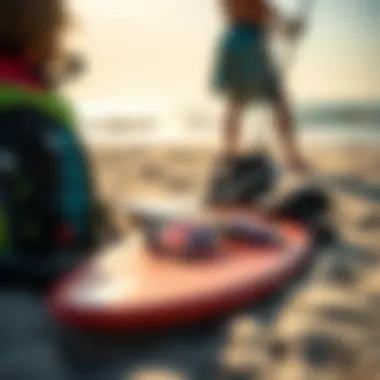
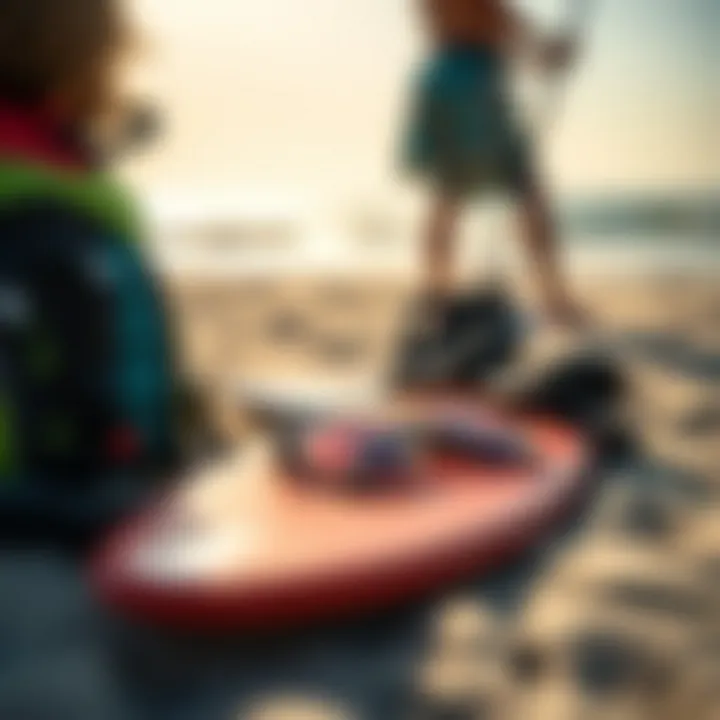
- Directional Boards: These are designed like surfboards, ideal for riding waves. They're usually longer and provide better buoyancy, allowing you to enjoy the ocean swells of Charleston with finesse.
- Twin-Tip Boards: This type can be ridden in either direction, making them versatile for tricks and jumps. Most beginners find twin-tips easier to learn on; they’re pretty forgiving when it comes to balance.
- Foil Boards: A recent trend, foil boards allow riders to glide above the water surface by using a hydrofoil. This type is gaining traction in Charleston’s waters as it permits a different experience that promises less drag and faster rides.
Your ideal board ultimately depends on where you plan to ride, your experience, and how you like to ride. Think about your local spots, the water conditions, and what excites you most about kite surfing.
Safety Equipment
Safety shouldn't take a back seat, even when you're having a blast on the waves. The right safety gear not only protects you but also allows you to focus on having fun. Here are two crucial components:
Harnesses
Harnesses connect you to the kite and let the kite do the heavy lifting. A good harness can make your time on the kite significantly smoother. You can find two primary designs:
- Waist Harness: This option sits around your waist, providing mobility for tricks and jumps. Many kite surfers prefer a waist harness for its comfort and flexibility.
- Seat Harness: These wrap around your legs as well as your waist, offering more support. They’re especially beneficial for those still getting the hang of it, giving stability and reducing the chance of back pain.
A quality harness is a must-have for controlled movements, enabling you to maximize your time on the water.
Helmets and Impact Vests
While kite surfing is known for its exhilaration, it comes with its risks. Helmets and impact vests can save you from unforeseen mishaps.
- Helmets: These aren't just for the thrill-seekers; with the right helmet, you can protect your head from unexpected falls or collisions, ensuring your water adventures remain enjoyable.
- Impact Vests: Providing buoyancy as well as protection, these vests allow you to float while minimizing injury from falls. Especially in Charleston's bustling waters, it’s a wise decision to strap one on.
Incorporating safety gear into your routine allows you to focus on perfecting your skills without unnecessary worry. Remember: surf responsibly to keep the fun alive!
In summation, understanding and investing in essential gear is the first step to enjoying kite surfing. Each piece contributes not just to performance but also to your safety. So, before taking that leap into the air, make sure you are all set with the right equipment.
Kite Surfing Techniques and Tricks
The world of kite surfing off the coast of Charleston is vibrant and ever-evolving. Understanding the various techniques and tricks can elevate your experience from merely riding the waves to performing stunning aerial feats. Mastery in this sport is not just about the adrenaline rush; it’s about finesse, control, and continuous learning. For both novices and seasoned veterans, enhancing your skill set can lead to greater enjoyment and safety while out on the water.
Starting with the Basics
Before diving into the deep end of kite surfing, it's crucial to build a solid foundation. Each rider begins by familiarizing themselves with the kite and its dynamics. Here are some fundamental techniques:
- Kite Control: Learn to steer your kite with precision. This skill is essential as it directly influences your speed and direction.
- Body Dragging: This technique helps beginners get accustomed to the water and kite's power without the board. By body dragging, you learn how to navigate the water with the kite’s pull while mastering balance.
- Water Start: This is where many kite surfers start feeling the thrill. The water start technique involves getting up on the board while keeping the kite in the right position. A good instructor will guide you through this, helping you learn the importance of edge control and weight distribution.
- Understanding Wind: It's also critical to know how to read the wind. Understanding gusts, shifts, and pattern changes can prevent accidents and make your ride smoother.
As you practice these basic skills, remember to keep an eye on your body positioning and kite angle. With time, control will become second nature, setting you up for more complex moves down the road.
Progressing to Advanced Maneuvers
Once you feel confident with the basics, it's time to explore advanced maneuvers that can wow your friends and turn heads on the beach. Advanced techniques require both mental and physical readiness:
- Jumping: This maneuver involves using the kite's power to propel yourself into the air. Timing your movements with the kite’s pull is key. Bend your knees, edge the board against the wind, then pull up on the bar as you straighten your legs to take off.
- Tricks: Whether you want to attempt a backflip or perhaps a grab, advanced tricks demand practice. Start by mastering simple grabs like the Indy or stale fish, and gradually incorporate spins and flips.
- Transitions: A smooth transition can enhance your riding style. Mastering front-to-back transitions and 180-degree turns can help showcase your skill level. Focus on your kite positioning and body angle.
- Downloops: Perfecting downloops can add that extra flair while jumping. This involves turning the kite sharply to create significant pull as you descend. It's adrenaline-packed but requires precision and control.
"The only limits that exist are the ones we place on ourselves."
To truly excel in kite surfing, one must adopt a mindset of continual learning. Consider joining local kitesurfing communities or attending workshops. The camaraderie you find within these groups often brings invaluable insights. Engage in open discussions; many experienced surfers are happy to share tips and tricks from their own journeys.
As your skills progress, don’t forget to respect safety measures and local regulations. Enjoy the thrill of mastering kite surfing, blending skill and enjoyment into an exciting, worthwhile venture.
Safety Practices for Kite Surfing
When it comes to kite surfing, safety should be the top priority. It's not just about the thrill of catching the wind; it's about ensuring that you can enjoy the experience without unnecessary risks. Kite surfing involves dynamic forces and movements, making it crucial to approach each session with the right mindset and habits. Proper safety practices can prevent accidents and make your time on the water not only enjoyable but also secure. Knowing how to check your gear and being prepared for emergencies can mean the difference between a great day out and a potentially dangerous situation.
Pre-flight Safety Checks
Before launching your kite, a thorough pre-flight safety check is essential. It is a routine that can save lives and ensure everything runs smoothly. Start by inspecting your equipment: check the lines for any frays or knots, and ensure that your kite is clean and free from sand or debris. The integrity of your gear is paramount.
Here’s a checklist to help you through:
- Inspect the Kite: Look for tears, punctures, or any irregularities.
- Check the Lines: Make sure there are no tangles or damage; line control is crucial for maneuverability.
- Harness Condition: Ensure your harness is not cracked and fits properly. An ill-fitting harness can lead to complications.
- Safety Systems: Verify that all quick-releases and safety systems are functioning correctly. These are your lifelines in case things go awry.
The walkthrough of these checks might seem like a chore, but taking the time to do them pays dividends later in your session. Pay particular attention to environmental factors, too. Know the wind conditions for the day—higher winds require more caution. Ensure you are aware of your limits and recognize when to abandon a session if conditions become unpredictable.
Emergency Protocols
Despite all precautions, emergencies can still happen. Therefore, having a solid plan makes all the difference. Familiarizing yourself with emergency protocols can prepare you for unexpected situations. Here are some critical actions to consider:
- Know Your Spot: Every kite surfer should be well-acquainted with their chosen location. Know where to head if things go south, be it a quick retreat to the shore or signalling help.
- Emergency Signals: Establish clear hand signals with fellow kiters before hitting the water. If someone needs assistance, concise communication can facilitate a faster response.
- Leash and Equipment Management: Familiarize yourself with your gear's leash. If you lose your board or kite, having a plan for retrieval can keep you safe.
- Stay Calm: Panic is the enemy during an emergency. If you find yourself in a precarious situation, focus on breathing and conscious thought. Assess what needs to be done and act accordingly.
Maintaining focus on safety allows you to enjoy the exhilaration of kite surfing while minimizing risks.
"Preparation is the key to success."
This principle holds true for kite surfing as well. A thorough safety practice will not only safeguard your physical well-being but also enrich your experience on the water.
Local Community and Culture


Kite surfing thrives within the fabric of local communities. In Charleston, this sport is not just an activity; it embodies a vibrant lifestyle that connects enthusiasts and fosters a sense of belonging. Understanding this community is crucial for anyone looking to dive into the exhilarating world of kite surfing.
Finding a Kite Surfing Group
Membership in a kite surfing group can be a game changer for both beginners and seasoned surfers. Such groups not only provide a platform for skill exchange but also create opportunities for friendship and camaraderie. In Charleston, where the kite surf scene is lively, you’ll find numerous local clubs and organizations eager to welcome new faces.
For instance, organizations like the Charleston Kiteboarding Association serve as great resources, offering everything from mentorship to organized meetups on the water. Their forums frequently discuss safety and local regulations, making them invaluable allies for newcomers. Additionally, these groups often set up informal gatherings at popular spots like Folly Beach, turning an ordinary session into a communal experience.
When you participate in these groups, you amplify your learning curve. You can pick up tips about navigating deeper waters, wind conditions, and the best spots to hit at different times of the year. Plus, kite surfing with others can be an absolute blast; it’s like a family reunion on the waves.
Events and Competitions
The spirit of kite surfing in Charleston is palpable during local events and competitions. These gatherings not only showcase the best talent the area has to offer but also bring together elated enthusiasts who share that same passion for the sport. From small contests at Sullivan’s Island to larger events, these occasions are perfect for building community ties and pushing personal limits.
One well-known event is the Charleston Kite Festival, usually held in early spring. It's a vibrant celebration attracting participants from surrounding areas. The day is filled with both amateur competitions and thrilling demonstrations by professional kite surfers. Events such as these offer a chance to meet others in the community, share experiences, and witness the sport's evolution firsthand.
Participating in competitions helps hone your skills; you’ll discover your strengths and identify areas for improvement. Plus, the excitement of competing adds an adrenaline rush that makes every kite session worth it. For those watching, it’s a golden opportunity to gather tips from seasoned pros while enjoying spectacular displays of aerial maneuvers.
Staying connected with local organizations and events will enrich your kite surfing journey, allowing you to grow not just as a surfer, but also as a member of a thriving community. The relationships formed here over shared experiences can last a lifetime, making kite surfing in Charleston all the more rewarding.
Lessons and Training
Kite surfing, while an exhilarating experience, is not without its challenges. For those eager to dive into this sport, lessons and training hold major significance. Learning from qualified instructors can elevate your skills faster while ensuring a safer kite surfing experience along the beautiful shores of Charleston, SC.
Finding Qualified Instructors
When stepping into the kite surfing world, finding the right instructor can be a game changer. Not all teaching styles fit each person's learning needs. Look for instructors who are certified and come highly recommended by local kite surfing communities. A good instructor should have:
- Experience: They should have years of kite surfing experience, along with teaching expertise.
- Certification: Look for instructors certified by organizations like the International Kiteboarding Organization or similar affiliations.
- Local Knowledge: Someone familiar with Charleston beaches can provide insights on local wind patterns, tide schedules, and even the best spots for beginners.
Joining local social media groups or forums can be a goldmine for recommendations. Websites like reddit.com or local Facebook groups dedicated to water sports can serve as excellent resources for finding trusted educators in the area.
Personal Training Recommendations
While group lessons might seem appealing, individual training often produces faster results tailored specifically for your progress. A few personal training tips include:
- Initial Assessment: An instructor should start with an assessment of your skills, comfort in water, and knowledge of equipment. This ensures they tailor your training effectively.
- Progressive Learning: Focus on lessons that start with the basics – getting comfortable with the gear before advancing to techniques like jumping or tricks.
- Frequent Practice: The key to getting the hang of kite surfing is consistent practice. Even if it means simply handling the kite on the beach before hitting the water.
- Safety Emphasis: A great instructor not only teaches you to ride but also emphasizes safety practices in various conditions. Understanding how to react in emergencies is crucial.
"It’s not just about flying high but flying safely and responsibly. Make sure you learn the rules of engagement in the wind and surf."
- Feedback: Ensure that the instructor gives you constructive feedback. Identifying areas to improve helps accelerate your learning curve.
Finding the right lessons and personal training can not only prepare you for thrilling adventures on water but also bolster your confidence as a kite surfer. By investing in quality instruction, you'll be one step closer to mastering the surf and enjoying Charleston's breathtaking coastal beauty.
Travel Considerations and Regulations
Understanding the travel considerations and regulations around kite surfing in Charleston is vital for ensuring a smooth and enjoyable experience. Navigating the intricate web of transportation logistics and adhering to local laws not only helps avoid unnecessary hiccups but also enhances your overall satisfaction in engaging with this thrilling sport.
Traveling with Gear
When it comes to traveling with kite surfing equipment, planning ahead can save you a world of trouble. Most serious kite surfers know that lugging around gear can feel like hauling a small elephant. Here are some practical tips to make the journey smoother:
- Packing Efficiently: Ensure that your kite and board are securely packed. There are specialized bags designed for kite gear that provide added protection. Consider investing in a good quality travel bag that can fit both your gear and any additional necessities.
- Airline Policies: Different airlines have varying rules about sporting equipment. It’s best to check these beforehand. Some may charge additional fees, while others could restrict weight or size limits. Reading the fine print helps avoid that awkward moment at the check-in counter.
- Local Transport Options: Whether you’re renting a car or relying on local transport, factor in the space you’ll need for your gear. Some taxis or shuttle services may not accommodate oversized items well. You might want to think about bike racks or roof racks for added convenience.
Not to be forgotten, make sure that you also have a detailed inventory list of your gear. This can come in handy, especially if any equipment goes missing or is damaged during transit.
Local Regulations for Visitors
Kite surfing in Charleston, while exhilarating, is subject to local laws that every visitor should be aware of. Abiding by these regulations not only ensures the safety of all beachgoers but also preserves the natural beauty of these coastlines. Here’s a brief rundown of important points:
- Designated Areas: Many beaches may have specific zones where kite surfing is allowed. Familiarizing yourself with these areas will ensure you don’t inadvertently wander into a restricted zone.
- Permits and Licensing: Check if you need a permit to kite surf at certain locations. Some spots require a fee or registration, especially during peak seasons.
- Respecting Wildlife: Charleston's coastal regions are home to various wildlife, including nesting shorebirds. Keep your distance from these protected areas and follow any posted signs regarding kite surfing.
"When kite surfing in unfamiliar territories, being aware of local customs and regulations can save you from nuisance or even fines. Always respect the environment and fellow enthusiasts."
Following these regulations is not just about staying on the right side of the law; it’s also about being a responsible member of the kite surfing community. When everyone plays by the rules, it ensures a greater experience for all participants.
In summary, both traveling with gear and adhering to local regulations significantly contribute to a better kite surfing adventure in Charleston. With a bit of foresight and respect for the local culture, you can enjoy everything this beautiful location has to offer.
Ending and Future Insights
As we draw this exploration of kite surfing in Charleston, South Carolina to a close, it's essential to reflect on the significance of this beautiful sport in the region. Kite surfing isn't merely an activity; it's a vibrant part of Charleston's cultural fabric, intertwining adventure with community and the natural environment. The lively beaches and favorable wind conditions provide a unique backdrop where both seasoned professionals and eager beginners can thrive.
The Future of Kite Surfing in Charleston
Looking forward, the future of kite surfing in Charleston appears bright and promising. Here are a few key elements to consider:
- Growth of Local Communities: As interest in kite surfing continues to swell, we can expect more local clubs and community events to emerge. These gatherings play a pivotal role in fostering camaraderie and sharing knowledge among enthusiasts.
- Environmental Awareness: There's a rising trend toward sustainability within outdoor sports. Kite surfers in Charleston are increasingly engaging in environmental initiatives, helping preserve the stunning coastal areas that make their sport possible. Educating newcomers about respecting marine life and local ecosystems can become a crucial part of the kite surfing culture.
- Advanced Training Opportunities: With the sport’s increasing popularity, opportunities for professional coaching and clinics are likely to expand. These programs will help elevate the skill levels of local riders.
- Technological Innovations: The future may also bring innovative gear advancements, improving performance and safety. As manufacturers strive to meet the needs of riders, we might see more lightweight, durable kites and boards that allow for an enhanced riding experience.
"Kite surfing isn't just a sport; it's a way to connect with the wind, water, and a community of like-minded souls."
For more on kite surfing and its community, check out kiteboarding.com and join discussions on reddit.com/r/kitesurfing or explore events in your area through local Facebook groups.



